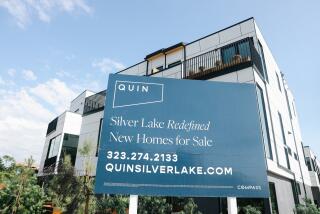Column: California’s real estate gold rush is even boosting Stockton, but at what price?
Not long ago, the Delta city of Stockton was drowning in bad news.
It went bankrupt. It led the nation in foreclosures during the housing crash. It found itself on a list of the most miserable places to live in America. It was too far from job centers. The crime rate was high and a former mayor got slapped with criminal charges.
But now Stockton – something of a northern cousin of once-bankrupt and long-beleaguered San Bernardino -- finds itself at the top of a list of California cities with the greatest increase in home prices over the last five years, at 92%.
What happened?
How Stockton went from bust to boom
For one thing, the San Joaquin River port city had fallen so far, it had the most ground to make up.
For another, nearby burgs like Tracy, which is closer to jobs in the Bay Area and Silicon Valley, have become too expensive for many people.
The housing affordability crisis, in other words, has given a boost to Stockton, where you can still buy a nice family home in the $200,000 to $350,000 range.
But recovery can be a double-edged sword.
“Now we’re seeing rent increases, and it’s not like Coastal California, but we’re starting to have signs of housing shortages and rising prices,” said Jeff Michael, director of the Center for Business and Policy Research at University of the Pacific in Stockton.
Stockton Mayor Michael Tubbs said it’s nice to see the housing market bounce back, but he’s concerned about all the residents who will only fall farther behind as neighborhoods gentrify and costs rise.
“The median income here is $43,000, and that doesn’t equate to being able to buy a house for $300,000,” said Tubbs.
If people are feeling the squeeze in a town recently called a miserable place to live, is any California outpost safe from the affordability crisis?
On a recent Saturday, I checked out the action at several open houses in Stockton, including a three-bedroom, two-bath home with a swimming pool on Azalea Way.
“We already have one offer on the house,” real estate agent Wendy Barbieri told a shopper.
The list price, by the way, was $364,950.
This was in Lincoln Village, a leafy, upscale neighborhood with some of the city’s better schools. This same house, I guarantee you, would go for $1 million or more in much of Los Angeles, and closer to $2 million in Sunnyvale or Cupertino.
But as I was saying, when costs rise and fall, there are always winners and losers. Barbieri, the real estate agent, said longtime residents who want to move up to something a little bigger or nicer now find themselves in competition with new arrivals willing to make wretched commutes.
“There’ve been a lot of cash offers,” said Barbieri, “with buyers being outbid like crazy by cash that’s coming from the Bay Area.”
At another open house, I met a flipper, which is always a sign that prices are going up. Debra Chen said she bought a house for $172,000 and put between $50,000 and $70,000 into an upgrade. Now it’s listed for $289,999.
In a bucolic neighborhood called Swain Oaks Manor, I walked through a $349,000 listing and then met a neighbor outside. Robert Lovato, a retired teacher, didn’t see an up side to rising prices.
“It’s not good for me,” said Lovato. “It just means my taxes are going to go up.”
On the other side of that problem are Dianne and Alvin Reyes. They rented in the Milpitas-Fremont area with Dianne working as a physical therapist and Alvin as an engineer at Tesla, but they were outbid on houses they could barely afford, and rents kept rising. So they recently bought a four-bedroom house in Stockton for $345,000, and Dianne got a job close to home. Her husband, however, still commutes to Fremont, two hours down and two hours back.
“What we pay now is much less than what we paid for our rental,” said Dianne, who hopes her husband can eventually work out a transfer to a closer Tesla plant.
Deborah Gelbart, a medical assistant at an Oakland hospital, was a lifelong renter and lived near her job. But like so many other Californians who make decent money and do essential work, she was hit by the twin curses of rising rents and flat pay. So she just bought a three-bedroom in Stockton for $220,000, signing up for a long commute.
“I love my little house,” Gelbart said, telling me her new home is her first, and she sees it as an investment she might one day pass on to family.
Mayor Tubbs just bought a house himself. He said he paid $375,000, after being outbid on another one he was interested in.
Tubbs, by the way, is the son of a single mother and an incarcerated father won a City Council seat when he was 21, with Oprah Winfrey among his campaign donors. When the former White House intern became mayor last year at the age of 26, one of his endorsements was from President Obama.
Tubbs is a Stanford grad, and my interview with him had to be delayed because he was on his honeymoon after marrying his college sweetheart, a Gates scholar who is studying for her doctorate in Cambridge.
Success doesn’t have to mean leaving Stockton
Given the couples’ credentials, it seems there might have been a few other options than anchoring in Stockton. But home is home, and Tubbs was drawn to the challenge of turning around the city that took so much abuse when he was a youngster.
“As kids, you internalized it,” Tubbs said of Stockton’s years-long struggles and dubious distinctions. “I think that’s why so many folks of my generation thought that success meant leaving Stockton.”
Now he finds himself working on crime, poverty, blight and homelessness even as he deals with the ups and downs of gentrification. In that regard, he’s no different from dozens of other mayors in California.
“We’re stressing the need for all types of housing, including multi-family and high-density housing, and we’ve got a couple of projects coming to downtown,” said Tubbs, speaking from a City Hall office near the river, the marina, arts centers and the minor league baseball stadium, so the potential is there.
He said he wants to find ways to finance affordable housing, and he wants to streamline the building permit process to cut down on development costs and keep prices lower.
Tubbs has no authority over the school district, but said he’s begun forming alliances with educators because a better educated workforce could draw more business and higher-paying jobs to Stockton, which will soon be home to an Amazon distribution center expected to employ 1,000 people. Amazon, Tesla and other big employers already have operations in nearby Tracy, Manteca and Lathrop, and Stockton is the next city down the line.
It would be hard not to root for a city down on its luck for so long, and in many ways, the Stockton challenge is the state challenge.
California is blessed to have the resources, jobs and wealth that it has, but the economy booms only for those who are highly educated or have specialized skills and can throw crazy money at houses in bidding wars that put homes further out of reach for everyone else. Too many Californians are doomed to budget-sucking housing costs and nightmarish commutes that impact the environment and quality of life. You have to wonder how long an affordable house in Stockton will still be an acceptable tradeoff for those who lose three or four hours each day to get to work and home.
With the governor’s race about to launch, the candidates need to explain how they can help mayors like Tubbs design communities that put jobs closer to homes and work better for people of all income levels. That means more transit, more telecommuting, better education, higher wages and finally, more housing, so the added supply brings down prices that are suffocating far too many people.
If California has a bigger challenge these days, it has not crossed my desk.
Get more of Steve Lopez’s work and follow him on Twitter @LATstevelopez
More to Read
Start your day right
Sign up for Essential California for news, features and recommendations from the L.A. Times and beyond in your inbox six days a week.
You may occasionally receive promotional content from the Los Angeles Times.







